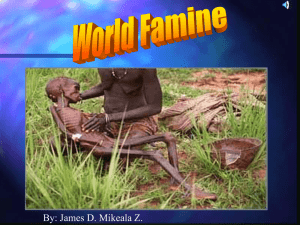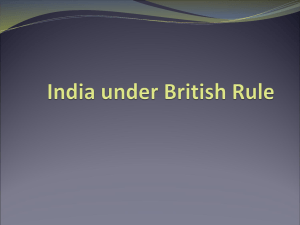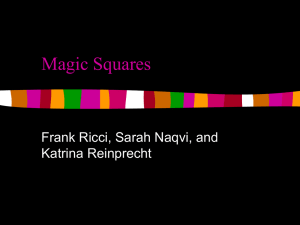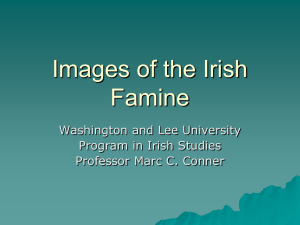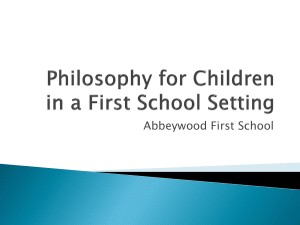The Boy Who Harnessed The Wind
advertisement
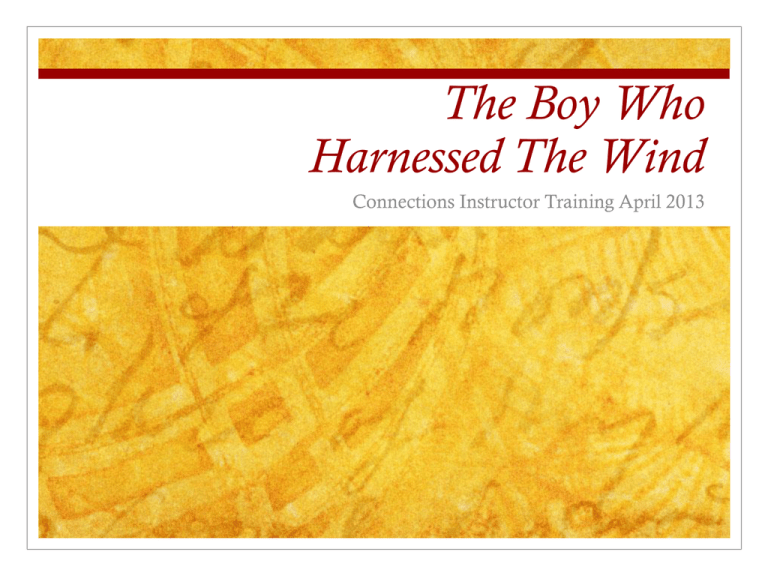
The Boy Who Harnessed The Wind Connections Instructor Training April 2013 Thematic Approach This novel is comprised of three themes: Magic Science Famine Themes can allow for different teaching approaches Basic Teaching Approaches Jigsaw Assign each student a group of three Give each student a number designation 1 to 3 Send each member of the group to a larger group where they discuss and learn about one of the main aspects of novel. Students then return to their original group Students are responsible for teaching the rest of their original group In other words, they are the ‘expert’ of one main aspect of the novel Basic Teaching Approaches Cont. Fishbowl Three students with opinions on a thematic topic are selected Students circle around the three students and form a ‘fishbowl’ The circled students can ‘jump into’ the center group of three if they have something to say Basic Teaching Approaches Cont. Small group discussions Give each group a passage or theme to discuss Ask students to report back to the entire class about their topic Engage the entire class in an overall discussion of the topic Basic Teaching Approaches Cont. Think, Pair, Share Give students a topic to think about Give them time to think about their response Pair them up with a fellow student and have them discuss their thoughts Start a classroom discussion All students should have something to say; encourage discussion Themes: Famine Many challenges possible: Students are possibly unfamiliar with how it feels to not have food Inability to relate personally may lead to fruitless discussions However, the novel offers a good atmosphere for understanding and empathizing with Famine Utilize student empathy to engage them in the topic To get the ball rolling, tap into everyday student behavior Famine Teaching Tools: Food Journal A food journal is a record of all the food a person eats during a period of time. Journals include: Food quantity Time eaten Money spent Calories Students gain awareness of their own food intake May promote understanding of the severity of famine & what the characters endured Famine Teaching Tools: Cook a Traditional Meal Using your budget from the Connections program, cook a meal approximating the size of a famine meal Use the novel as a guide to food quantity Gives students a hands on approach to understanding food quantity Students can estimate their likelihood of survival Students can also estimate the likelihood of family groups surviving Famine Teaching Tools: Interactive Ideas Ask the Dietician from the Student Health and Wellness Center to come talk to your class about the physical and mental issues surrounding famine. Ask a refugee or international student from a third world country come speak to your class about their experiences. Ask relief workers or volunteers come to your classroom and discuss their experiences with famine and other disasters. Themes: Science Science is representative of: 1) hard work 2) innovation 3) determination Students understand these larger concepts from their own lives Tapping into these themes is fairly simple Write a journal about a time these concepts changed the outcome of something in their lives In small groups, discuss their anticipated lives in college and how these concepts apply Science Teaching Tools: Removing Technology Technology is integral within the novel. Removing technology can demonstrate technology’s impact: At the beginning of one day leave the lights and computer off Ask them to turn in their electronics Some students will resist; be adamant that they will get them back Run class without technology without explaining to the students why Discuss how it changed their perceptions of classroom & school work Science Teaching Tools: Interactive Ideas Discuss the importance of technology in our current society and how we use and misuse it. Current examples from the media will be useful here Have a professor or graduate student in Engineering give a brief demonstration of windmill and electronic technology. Have students log their technology usage in their day to day life. Lead a discussion about how technology is both useful and detrimental Lead a discussion about ‘how much technology is too much?’ Themes: Magic Magic, like science, is representative of familial and social traditions. William’s family, tribe, and city are steeped in magical ideas Magic tends to explain some of the societal issues within Africa and Malawi Even though students may not be steeped in magic, they understand tradition Utilize their familiarity with tradition to relate to the novel Magic Teaching Tools: Oral Stories Students will all have stories from their own lives that are passed down by oral tradition. Have students write a one page story from their lives Let a few intrepid students present their stories in class Tell students to present in ‘campfire mode’ Speak as if they were around a camp fire presenting these ideas Magic Teaching Tools: Oral Stories Cont. Once finished with their stories, ask students to review them: Evaluate objectively Look for exaggerations and overstatements Students start to see that magic, like our exaggerations, helps to present a different perspective Open a class discussion on why stories are important to every culture How does their own culture use stories socially? Magic Teaching Tools: Interactive Ideas Visit the Anthropology and/or Art museum and discuss what stories are told through the presented artifacts or artworks. Ask a Folklore professor discuss the importance of stories and their utility. Ask students to compose and tell a collective narrative about their connections class. Each student uses one sentence that will build on the sentence of the previous person Questions and Discussion
